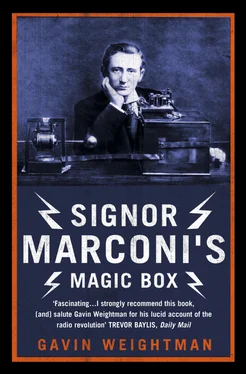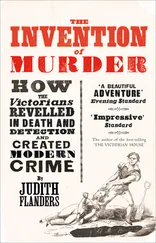Presently a fair-haired young man takes the chair, self confidence and reserve force in every gesture. Away he goes, and his transmission is as swift and pure as a mountain stream … The audience, enthralled, forgets the speed, and hearkens only to the beauty of the sending. On and on fly the dots and dashes, and though it is clear that his pace is not up to that set by the leaders, nevertheless there is a finish – an indefinable quality of perfection in the performance that at the end brings the multitude to its feet in a spontaneous burst of applause; such an outburst as might have greeted a great piece of oratory or acting.
Marconi was at this time using exactly the same shining Morse keys as the contestants used for their New York sending competition. But he could not hope to match their speed, and certainly nobody would hearken to the beauty of his sending. Each dot and dash sent by wireless was created by a deafening spark – the operators soon took to wearing earplugs. At the receiving end, if the operator was using headphones, which was soon the regular practice, the noise of interference was also disturbing and uncomfortable. It was like listening intently to a station improperly tuned on the radio. There was no tuning in the modern sense of finding the exact point on the wave spectrum to receive a transmitter’s signal. And wireless telegraphy was painfully slow. When in 1897 Marconi returned briefly to Italy to fulfil his obligation to carry out his military service, he demonstrated his invention to the navy at La Spezia. On that occasion each Morse dot required the transmitting lever to be held down for five seconds, and each dash for fifteen seconds. The letter ‘H’ alone (dot, dash, dot, dot, dot) took more than half a minute to send. The messages relayed to and from the royal yacht Osborne were equally laborious.
Lack of speed was not, however, Marconi’s greatest concern. He needed to prove not only that his system worked, but that it could span distances which the leading scientists of the day insisted were unattainable. Unless he could send messages hundreds of miles, he could never compete with the cable telegraph, and wireless would have only a restricted value for ships at sea. The widely accepted view was that because the earth was round, a spark signal transmitted from any point on land would head off over the horizon, keep going until it reached the upper atmosphere and head out into space. There was no reason to believe that electro-magnetic waves would ‘hug’ the surface of land or sea. However high you raised your transmitting and receiving aerials, the signal could be picked up no further than the line of sight between the topmost points. Marconi, and those working with him, had no theory to contradict the received wisdom. All they could do was carry on blindly, in the hope of demonstrating that the theory was wrong.
The degree to which Marconi was able to inspire confidence in his assistants, most of whom were a good deal older than him – he was just twenty-five in 1899 – was remarkable. Quiet and modest though he was in his dealings with the press, Marconi evidently had a messianic quality in his workshops in the Royal Needles Hotel on the Isle of Wight and the Haven Hotel in Poole. He led by example, often working into the night.
The detective writer turned wireless sleuth for McClure’s, Cleveland Moffett, visited both these stations in 1899, and chatted to Marconi and the engineers working with him. One of these was Dr Erskine Murray, based at the Haven Hotel, where he sometimes tuned up his cello to make up a trio with Marconi and his brother Alfonso. Moffett wrote:
… after a breezy ride across the Channel on the self-reliant side-wheeler ‘Lymington’, then an hour’s railway journey and a carriage jaunt of like duration over gorse-spread sand dunes, I found myself at the Poole Signal Station, really six miles beyond Poole, on a barren promontory. Here the installation is identical with that at the Needles, only on a larger scale, and here two operators are kept busy at experiments, under the direction of Mr. Marconi himself and Dr. Erskine-Murray, one of the company’s chief electricians. With the latter I spent two hours in profitable converse.
‘I suppose,’ said I, ‘this is a fine day for your work?’ The sun was shining and the air mild.
‘Not particularly,’ said he. ‘The fact is, our messages seem to carry best in fog and bad weather. This past winter we have sent through all kinds of gales and storms without a single breakdown.’
‘Don’t thunder-storms interfere with you, or electric disturbances?’
‘Not in the least.’
‘How about the earth’s curvature? I suppose that doesn’t amount to much just to the Needles?’
‘Doesn’t it though? Look across, and judge for yourself. It amounts to 100 feet at least. You can only see the head of the Needles lighthouse from here, and that must be 150 feet above the sea. And the big steamers pass there hulls and funnels down.’
‘Then the earth’s curvature makes no difference with your waves?’
‘It has made none up to twenty-five miles, which we have covered from a ship to shore; and in that distance the earth’s dip amounts to about 500 feet. If the curvature counted against us then, the messages would have passed some hundreds of feet over the receiving-station; but nothing of the sort happened. So we feel reasonably confident that these Hertzian waves follow around smoothly as the earth curves.’
‘And you can send messages through hills, can you not?’
‘Easily. We have done so repeatedly.’
‘And you can send in all kinds of weather?’
‘We can.’
‘Then,’ said I after some thought, ‘if neither land nor sea nor atmospheric conditions can stop you, I don’t see why you can’t send messages to any distance.’
‘So we can,’ said the electrician, ‘so we can, given a sufficient height of wire. It has become simply a question now of how high a mast you are willing to erect. If you double the height of your mast, you can send a message four times as far. If you treble the height of your mast, you can send a message nine times as far. In other words the law established by our experiments seems to be that the range of distance increases as the square of the mast’s height. To start with, you may assume that a wire suspended from an eighty-foot mast will send a message twenty miles. We are doing about that here.’
‘Then,’ said I, multiplying, ‘a mast 160 feet high would send a message eighty miles?’
‘Exactly.’
‘And a mast 320 feet high would send a message 320 miles; *a mast 640 feet high would send a message 1280 miles; and a mast 1280 feet high would send a message 5120 miles?’
‘That’s right. So you see if there were another Eiffel Tower in New York, it would be possible to send messages to Paris through the ether and get answers without ocean cables.’
‘Do you really think that would be possible?’
‘I see no reason to doubt it. What are a few thousand miles to this wonderful ether, which brings us our light every day from millions of miles?’
It was the universal belief among scientists at the time that light waves could not exist in a vacuum, but must travel through something, and so too with electro-magnetic waves. What that something was, nobody knew, but it was given the name ‘the ether’, and was conceived of as a very thin, colourless, odourless jelly, in which the whole of the universe was set. The most common way of explaining ‘wireless waves’ was with the analogy of throwing a stone into the still waters of a pond and watching the ripples spread out in ever larger circles. There was some popular confusion about the term ‘ether’, for it was also the name of a gas which was an early form of anaesthetic. When scientists referred to the ether it was sometimes imagined as a vapour, but really it made no differenece what it was. Marconi believed in its existence, and as far as he was concerned it had some special property which enabled the electro-magnetic waves he sent out to travel much further than they were supposed to.
Читать дальше












